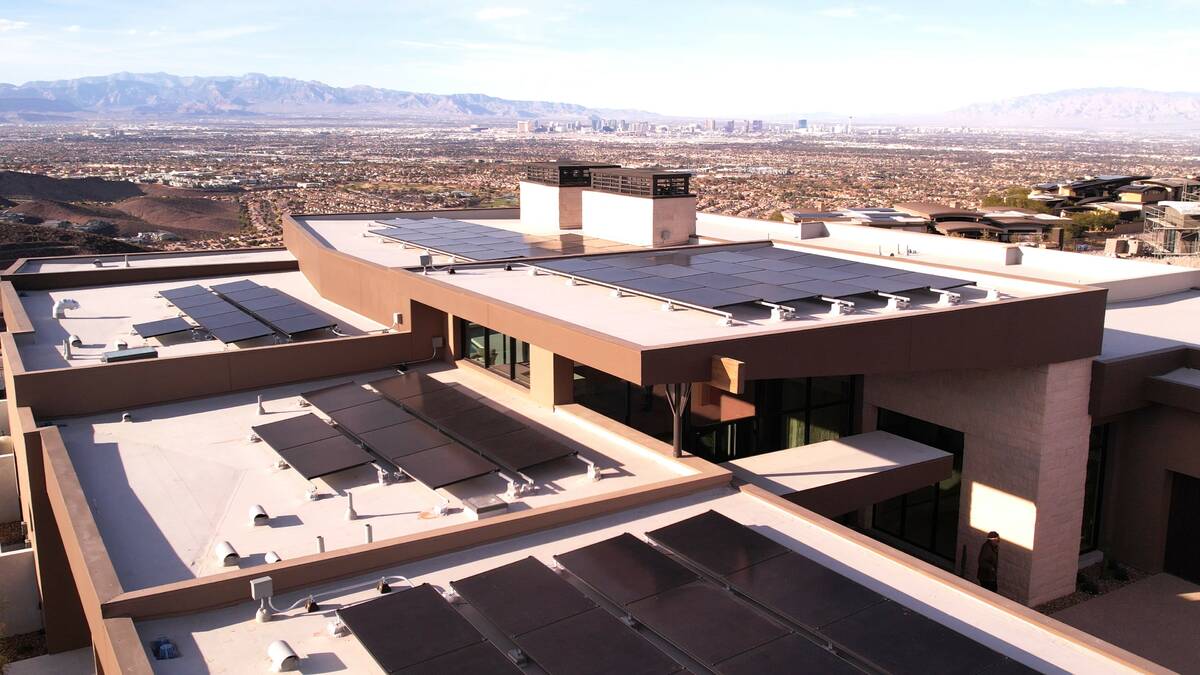The sun shines brightly on the Las Vegas Valley about 300 days every year.
Some luxury homeowners in this region have employed photovoltaic solar panels, integrated battery energy storage systems and active energy-management applications to provide additional power, comfort and energy resilience to their spacious dwellings.
Although a mix of federal and state laws will affect all homeowners looking to add solar, many luxury buyers are still opting for energy efficiencies, solar and smart technology to save power.
Federal laws
In July, Congress passed HR 1, and it was signed into law. Among other budget cuts, HR 1 repealed the Inflation Reduction Act of 2022 and discontinued a federal Investment Tax Credit of 30 percent for all residential home solar power installations that had originally been scheduled to extend through 2032. After the end of 2025, residential homeowners who plan to install photovoltaic solar panel systems will no longer be able to claim a 30 percent investment tax credit against their annual federal income taxes during the 2026 to 2032 tax years.
The payback period for solar panels in Nevada, where accumulated electricity generation by a home residential system covers the cost of the installation, is estimated to increase from 6.3 years to nine years without the Investment Tax Credit, according to solar calculator company, Energysage.
However, the Investment Tax Credit for Battery Energy Storage Systems of 30 percent was preserved by the U.S. Senate Finance Committee during negotiations with the U.S. House of Representatives. The ITC for residential home BESS systems will stay in effect through 2033.
Custom builders take on energy efficiency
Luxury homebuilders in the Las Vegas Valley have been following these trends closely, while also considering the changing costs, supply chains and consequences of federal government policies that have included tariffs on foreign-made components.
Daniel Coletti, owner of Sun West Custom Homes, designed and built The New American Home during both 2024 and 2025 as a showcase for the International Builders’ Show on behalf of the National Association of Home Builders.
Both luxury homes included photovoltaic solar panels, backup battery storage systems and active-energy management systems within the Ascaya community of Henderson.
However, these features were added only after Coletti spent a lot of time to design the most energy-efficient homes he could envision within the large living spaces.
“How am I going to make the battery storage system last through the night?” asked Coletti. “The only way is through energy efficiency, by drawing less power.”
He spent time considering the orientation of the home to the sun, the seasonal weather patterns, the use of insulation materials to create a tight thermal envelope inside the home without rooftop ventilation, an HVAC system with a high SEER rating, appliances that made efficient use of water and energy, LED lighting and a host of other interactive parameters.
Savant Systems provided interactive software control of an active energy management system for his most recent luxury home that was accessible from a mobile phone app.
“I can connect to my house from anywhere,” Coletti said. “I can see how much energy my solar panels are generating, how much electricity is going into the battery-storage system, and how much power my home is consuming. When I am away from the home or on vacation, I can turn off features and appliances that are not being used. Power shedding is a new feature offered within the luxury market.”
His design and construction efforts on The New American Home of 2025 were verified by an energy auditor and certified with a HERS energy-efficiency rating three times greater than a standard home of the same size.
Tyler Jones, CEO and founder at Blue Heron Design Build, has integrated biophilic features into his company’s material and technology choices, in order to create a more natural sense of well-being and comfort.
“The interest in rooftop solar power systems is high, but the take rate is not as high,” Jones said. “When people look at other features, like custom finishes that they want to build into their luxury homes, a lot of the time solar power and battery-storage systems are added later.”
Blue Heron pre-wires the conduit, cables and electrical connection points needed for the expansion of solar power, battery storage and other active energy management systems if the customer is considering an installation at a later date.
Jones has incorporated smart home operating systems from Savant into Blue Heron luxury home designs. These software control systems allow for the future expansion of smart home components that include rooftop solar panels and battery storage systems.
Blue Heron’s biophilic design approach includes energy efficiency. Smart architectural techniques integrate glass, steel, stone, wood and other building materials to orient the building structure within its natural landscape and avoid direct sunlight.
The results have been luxury homes that required less energy to cool during the summer months while also providing a feeling of well-being and internal comfort.
Blue Heron luxury homes have been featured all over the Las Vegas Valley, including communities in Ascaya, Lake Las Vegas and other high-end neighborhoods.
State laws
The Nevada State Legislature this year passed new laws that have affected the installation of rooftop solar panels and battery storage systems for homes within the state. These new laws signed by Gov. Joe Lombardo promoted and strengthened a residential solar power industry that has provided thousands of jobs to the state economy.
Senate Bill 132 provided $500,000 to the Nevada Clean Energy Fund’s Solar For All program, that will deliver solar power products to underserved households in Nevada.
Assembly Bill 458 will take initial steps to integrate affordable housing projects with solar power in order to make clean energy more accessible to all communities across the state.
SB 379 strengthened protections for solar buyers to opt out of solar power sales contracts, allowing a three-day consideration period for buyers under 60 years old and 10 days for buyers older than 60. The bill also prohibited sellers from providing false information about public utility costs, while also establishing clear rules for loans and power purchase agreements. Solar financiers are prohibited from disconnecting a customer’s system unless three consecutive payments have been missed.
SB 440 streamlined the solar power installation process for homeowners living within homeowners associations, or HOAs. The bill established a clear and fair process for submitting installation requests while also limiting the ability of HOAs to deny them or impose unreasonable conditions. An HOA cannot impose a requirement that increases total cost of a rooftop solar power system by more than 3 percent. The bill also increases disclosure requirements for solar installation companies, making installation agreements voidable if a solar company is not properly licensed.
Tips on how to add solar
When working on a home design with a solar power installation contractor, there are several guidelines that should define the relationship between the installer and the customer.
A solar power installation contractor should be chosen based on its availability, array of product lines, customization and installation options, historical track record of trusted work, payment/financing options, follow-up warranty guarantees and services.
A homeowner should employ a licensed contractor to ensure recourse in case something goes wrong with the installation. A licensed contractor should have a five-digit registration number that can be verified by the Nevada State Contractor’s Board through its website, nvcontractorsboard.com.
The NSCB maintains records of any customer complaints or legal action against each registered contractor while they are performing work within the state of Nevada. The NSCB has the authority to revoke the license of a contractor with too many installation infractions and can post a notice of termination to public records.
After the homeowner has chosen a vetted, licensed contractor, the customer should arrange a meeting to complete an in-person home assessment by the installer that considers the client’s home energy consumption and system expectations. A formal estimate should be given to the homeowner after the meeting.
If the homeowner consents to move forward after considering the estimate, an installer should then design a customized system and provide the customer with a contract to review. The contract should contain specific details that include specifications about the components of the solar power system, an installation timeline that includes permitting and inspection scheduling, as well as any component warranties, workmanship guarantees and follow-up service support.
After the homeowner has taken the time to study the details and terms of the installation contract, the installer should conduct a final review of the system with the homeowner before the contract is signed.
Once the contract is finalized, the installer should then pull the necessary permits for the solar power system to ensure the installation is up to code and legal.
After permits are approved, the contractor will schedule the rooftop solar power system installation, a procedure that generally should be completed in one to two days.
The contractor should then schedule a final inspection with the local utility company to obtain a “Permission To Operate,” or PTO.
Once approved by the utility inspection, the solar installer should then activate the customer’s system, as well as provide some kind of follow-up monitoring service to identify any workmanship problems or decreased energy production. Early detection of technical problems or workmanship defects can avoid potential system damage and maximize the long-term energy savings from the installation.
An additional service contract may be offered by the installer that includes remote monitoring by the solar installation company over the life of solar power system. Extended warranty provisions can include manufacturer’s warranty support, labor and workmanship warranties, roof leak warranty, periodic maintenance and terms of repair coverage, if needed.
Many solar power systems installed by solar companies include a mobile phone app that provides customers with a portal to monitor daily and cumulative home energy production.













